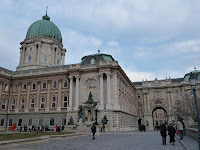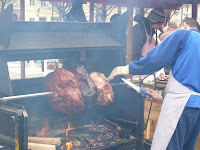Having traveled the last four months without the assistance of those nifty guidebooks, after the last one was pilfered, Heidi and I knew very little about Krakow's tourist attractions...save those which loom heavy in the hearts of many the world over.
Just outside of Krakow is the town of Oświęcim, which Hitler converted into a place of

imprisonment and extermination for Jews, Roma people, POWs, Polish intelligentsia and scores of others. I was drawn to the place and almost felt obligated to visit, not for the same reasons I was attracted to Iguacu Falls or the Parthenon, but because of something deeper. Perhaps it is the innate humanity within each of us which drew me to this place, to remember and pay homage to

the victims of one of the most horrendous acts of genocide the world has ever known. Moreover, it was important to stand amongst those hallowed grounds to reflect that man, although inherently good (in my humble opinion), is also capable of such evil atrocities. After all Hitler, Himmler and all of the rest of those involved in

these crimes against humanity were, indeed, human. As hard as it is to fathom, they had parents, and many went home to their children after, what they saw as, a hard day's work leading unknowing Jewish women and children into gas chambers which the victims believed to be disinfecting showers.
All told, it is estimated that approximately 1.5 million people were killed in the Auschwitz Death Camps in fewer than five years. Such a staggering figure is hard to truly grasp. Walking through Block 4 of the Auschwitz main camp one starts to get a small sense of the scale at which the murdering took place: huge piles of shoes, prosthetics and everyday items, such as brushes, pots and pans. Another room (which was closed during our visit) has just some of the 7 tons of human hair removed from the victims prior to extermination.

After being unloaded from crammed train cars the prisoners were sorted on site. With the wave of a finger an SS doctor would determine whether people were fit to work, or to be immediately sent to the gas chambers. About three-quarters of the people, including most women and children, were immediately sent to their deaths. Those that initially survived worked dreadfully long days, spending their evenings in cramped and unsanitary conditions, eating very little...about 20% of that recommended by nutritionists.
By the time the Red Army liberated the camp, in January 1945, the Nazis

had destroyed all but one of the crematories, in an attempt to hide evidence of their crimes. Only the weakest prisoners

remained when the Russians entered the camps, 7,500 in all. About 20,000 other prisoners were taken to a German concentration camp, on a forced march, when the Allied forces began closing in on the camp. (Many were liberated in April 1945 by the British.)
Needless to say, the visit was both powerful and solemn.
A couple of days later we visited the factory of Oscar Schindler, made famous by a Thomas Keneally book and Spielberg film.
A Nazi Party member and opportunistic businessman, Schindler came to Krakow shortly after the Germans took hold of the city. There he bought an old enamelware factory and used forced Jewish labour to make pots, pans and munitions. As the man witnessed atrocities, perpetrated by Nazi soldiers, he became increasingly protective of 'his' Jews, often regardless of personal risk or cost. All told, he is credited with saving the lives of 1,200 Jews

who would have, otherwise, almost certainly have been sent to the death chambers.
The museum itself is a well-designed, albeit lengthy, group of displays, focusing on life in Krakow during the Nazi invasion. Of course, there were also displays about Schindler's factory and numerous videos with reflections from survivors of the nightmare. If you go, give yourself about three hours...and sneak in a snack!
 In fact, we were right next to the loo which, as previous experience has shown me, can lead to some unpleasant odors. Luckily, however, nobody was sharing our four-bed cabin...at least not immediately.
In fact, we were right next to the loo which, as previous experience has shown me, can lead to some unpleasant odors. Luckily, however, nobody was sharing our four-bed cabin...at least not immediately.





















































